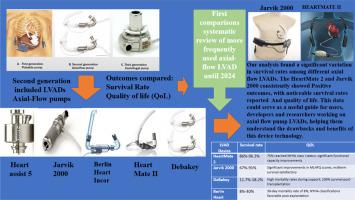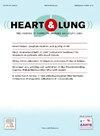Comparative analysis of survival rate and quality of life in axial-flow pump left ventricular assist devices (LVADs)
IF 2.6
4区 医学
Q2 CARDIAC & CARDIOVASCULAR SYSTEMS
引用次数: 0
Abstract
Background
The rising heart failure rates globally show the pressing demand for treatment progress, especially in Left Ventricular Assist Devices (LVADs). Axial-flow pump LVADs are gaining notice for their small size, few moving parts, and potential for miniaturization, providing a vital option for heart transplants during donor shortages.
Objectives
Despite several studies on LVADs, there is a notable lack of research specifically comparing axial-flow pumps with similar technology. This gap hinders the identification of the most optimal technology to guide development efforts and meet patient needs. This study aims to comprehensively compare the most commonly used axial-flow pumps and provide a detailed analysis focusing on survival rates and quality of life parameters.
Methods
As a developer of axial-flow pumps (LVADs), our group conducted a systematic review of the current axial-flow pump LVADs. We analyzed studies comparing these devices, focusing on key metrics such as survival rates and quality of life.
Results
The HeartMate 2 and Jarvik 2000 show superior survival rates (up to 86.9 % at 6 months, 96.3 % at 3 years) and (6-month survival 67 %-91 %) respectively, compared to the other axial flow pumps LVAD. The results underscore the importance of choosing the optimal device and informing the direction of future developments.
Conclusion
In this paper, we aim to inform future studies to enhance their effectiveness and advance the overall performance of these devices, ultimately benefiting patients and developers. This review furnishes evidence-based recommendations for the most appropriate axial-flow pumps based on survival rates and quality of life parameters.

轴流泵左心室辅助装置(LVAD)存活率和生活质量的比较分析
背景全球心力衰竭发病率不断上升,表明人们迫切要求在治疗方面取得进展,尤其是在左心室辅助装置(LVAD)方面。轴流泵 LVAD 因其体积小、活动部件少、微型化潜力大而备受关注,为供体短缺时的心脏移植提供了重要选择。这一空白阻碍了确定最佳技术以指导开发工作和满足患者需求。本研究旨在全面比较最常用的轴流泵,并对存活率和生活质量参数进行详细分析。方法作为轴流泵(LVAD)的开发者,我们的研究小组对目前的轴流泵 LVAD 进行了系统回顾。结果与其他轴流泵 LVAD 相比,HeartMate 2 和 Jarvik 2000 的存活率(6 个月存活率高达 86.9%,3 年存活率高达 96.3%)和 6 个月存活率(67%-91%)分别更高。本文旨在为未来的研究提供信息,以提高这些设备的有效性和整体性能,最终使患者和开发人员受益。本综述根据存活率和生活质量参数为最合适的轴流泵提供了循证建议。
本文章由计算机程序翻译,如有差异,请以英文原文为准。
求助全文
约1分钟内获得全文
求助全文
来源期刊

Heart & Lung
医学-呼吸系统
CiteScore
4.60
自引率
3.60%
发文量
184
审稿时长
35 days
期刊介绍:
Heart & Lung: The Journal of Cardiopulmonary and Acute Care, the official publication of The American Association of Heart Failure Nurses, presents original, peer-reviewed articles on techniques, advances, investigations, and observations related to the care of patients with acute and critical illness and patients with chronic cardiac or pulmonary disorders.
The Journal''s acute care articles focus on the care of hospitalized patients, including those in the critical and acute care settings. Because most patients who are hospitalized in acute and critical care settings have chronic conditions, we are also interested in the chronically critically ill, the care of patients with chronic cardiopulmonary disorders, their rehabilitation, and disease prevention. The Journal''s heart failure articles focus on all aspects of the care of patients with this condition. Manuscripts that are relevant to populations across the human lifespan are welcome.
 求助内容:
求助内容: 应助结果提醒方式:
应助结果提醒方式:


